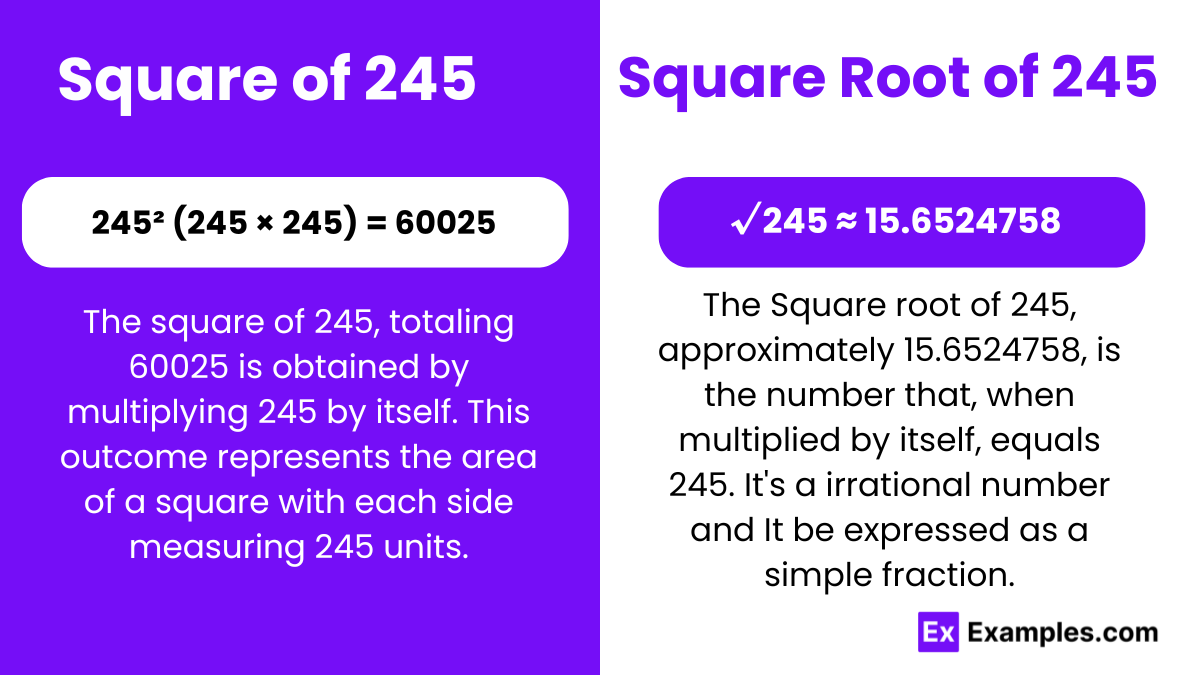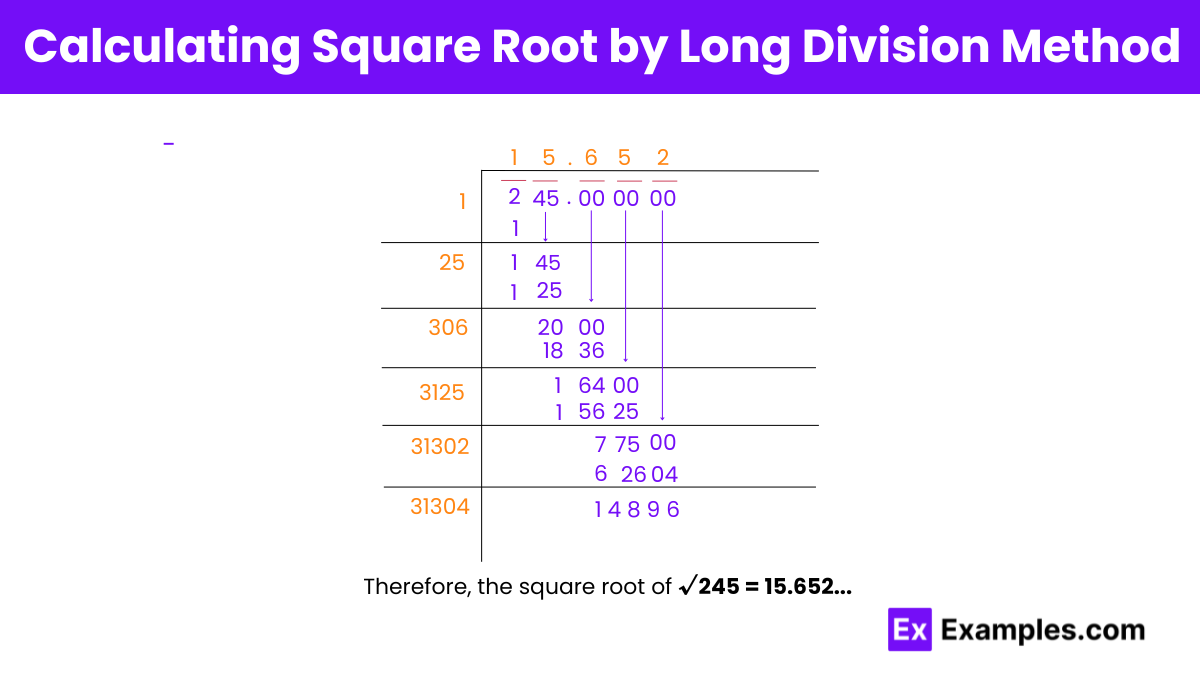What is the square of 245?
60025
60250
60500
60225


Within the realm of algebraic mathematics, squares and square roots are pivotal concepts. Squaring a number, like 245, involves multiplying it by itself, yielding 60025. This operation is foundational, crucial in exploring rational and irrational numbers. Understanding these basics enriches comprehension of mathematical relationships and patterns. Squares reveal inherent properties of numbers, while square roots unravel complex numerical mysteries. These concepts illuminate mathematical landscapes, guiding explorations into fractional territories. Mastery of squares and square roots empowers mathematicians to navigate diverse mathematical terrains, uncovering the elegance and complexity woven within algebraic frameworks.
The square number 245 equals 60025, derived by multiplying 245 by itself, a fundamental operation in algebraic mathematics, revealing inherent properties of numbers.
or
√245 ≈ 15.652 Upto 3 decimals
The square root of 245 is approximately 15.652. This fundamental operation in mathematics uncovers the value that, when multiplied by itself, equals 245.
Exponential Form: 245^½ or 245^0.5
Radical Form: √245
Rational Numbers: Rational numbers are those that can be expressed as the quotient of two integers, where the denominator is not zero. In other words, they can be written as fractions of the form a/b where (a) and (b) are integers and (b ≠ 0). Rational numbers include integers and fractions. Examples of rational numbers include 1/2, -3, and 5/7.
Irrational Numbers: Irrational numbers cannot be expressed as fractions of integers. Their decimal representations are non-repeating and non-terminating. These numbers cannot be represented as finite or repeating decimals. Examples of irrational numbers include the square roots of non-perfect squares like √2, √3, and √5, as well as transcendental numbers like π.
In essence, rational numbers can be expressed as fractions with finite or repeating decimals, whereas irrational numbers cannot be represented in this way, having non-repeating, non-terminating decimal expansions.
Prime Factorization Method: Break down 245 into its prime factors, which are 5 × 7 × 7. The square root of 245 is approximately 15.652, but since it doesn’t result in a perfect square, it remains an approximation.
Long Division Method: Use the long division algorithm to find the square root of 245 by approximation. Start with a guess (e.g., 15) and refine iteratively.
Using a Calculator: Most calculators have a square root function. Simply input 245 and find the square root directly.
Estimation: Since 245 is close to the perfect square of 256 (16 × 16), you can estimate that its square root is slightly less than 16.

Step 1: Pair the digits of 245 starting with the digit at one’s place. Place a horizontal bar to indicate pairing: 2|45.
Step 2: Find a number which, when multiplied by itself, gives a product less than or equal to 2. As we know, 1 × 1 = 1 < 2. So, 1 is the quotient and the remainder is 1.
Step 3: Bring down 45 to the right of 1, making the new dividend 145. Double the quotient obtained in Step 2, which gives us 2. Hence, 2 is the starting digit of the new divisor.
Step 4: Determine a digit to place at the unit’s place of the new divisor. Here, 5 works because 25 × 5 = 125 ≤ 145. Subtracting 125 from 145 gives us 20. The quotient now is 15.
Step 5: Bring down the next pair of zeros, making the new dividend 2000. Double the current quotient (15), resulting in 30, which becomes the starting digit of the new divisor.
Step 6: Determine the next digit to place at the unit’s place of the divisor. Here, 6 works because 306 × 6 = 1836 ≤ 2000. Subtracting 1836 from 2000 gives us 164. The quotient now is 156.
Step 7: Bring down the next pair of zeros, making the new dividend 16400. Double the current quotient (156), resulting in 312, which becomes the starting digit of the new divisor.
Step 8: Determine the next digit to place at the unit’s place of the divisor. Here, 5 works because 3125 × 5 = 15625 ≤ 16400. Subtracting 15625 from 16400 gives us 775. The quotient now is 1565.
Step 9: Bring down the next pair of zeros, making the new dividend 77500. Double the current quotient (1565), resulting in 3130, which becomes the starting digit of the new divisor.
Step 10: Determine the next digit to place at the unit’s place of the divisor. Here, 2 works because 31302 × 2 = 62604 ≤ 77500. Subtracting 62604 from 77500 gives us 14896. The quotient now is 15652.
Step 11: Bring down the next pair of zeros, making the new dividend 1489600. Double the current quotient (15652), resulting in 31304, which becomes the starting digit of the new divisor.
Step 12: Continue this process until you reach the desired level of precision. In this context, we would typically stop after a few decimal places.
The approximate value of the square root of 245, calculated to several decimal places, is around 15.652.
245 is not a perfect square because it cannot be expressed as the square of an integer. The square root of 245 is approximately 15.652, which is not a whole number, indicating that 245 is not a perfect square.
No, the square root of 245 cannot be simplified further because it is not a perfect square and its factors do not include any perfect square factor.
The prime factorization of 245 is 5 × 7 × 7, where 5 and 7 are prime numbers and 7 is repeated.
No, the square root of 245 cannot be expressed as a fraction in simplest form because it is an irrational number with a non-repeating, non-terminating decimal expansion.
The square root of 245 is closer to 15 than to 16. Specifically, it is approximately 15.652.
Text prompt
Add Tone
10 Examples of Public speaking
20 Examples of Gas lighting
What is the square of 245?
60025
60250
60500
60225
What is the approximate square root of 245?
15
16
17
18
If the square root of a number is 15.652, what is the square of that number?
245
250
255
260
Which of the following numbers is closest to the square of 245?
60000
62000
60500
61000
What is the exact value of 245 squared?
60000
60250
60025
60200
If the square of a number is 60025, what is the number?
245
250
240
245
What is the nearest whole number to the square root of 245?
14
15
16
17
What is the approximate square root of 245 to two decimal places?
15.25
15.65
15.75
15.85
How do you determine the square root of 245 using a calculator?
Enter 245 and press the square root button
Multiply 245 by itself
Divide 245 by 2
Add 245 to itself
What is the result of squaring the approximate square root of 245 (15.65)?
225
245
240
250
Before you leave, take our quick quiz to enhance your learning!

